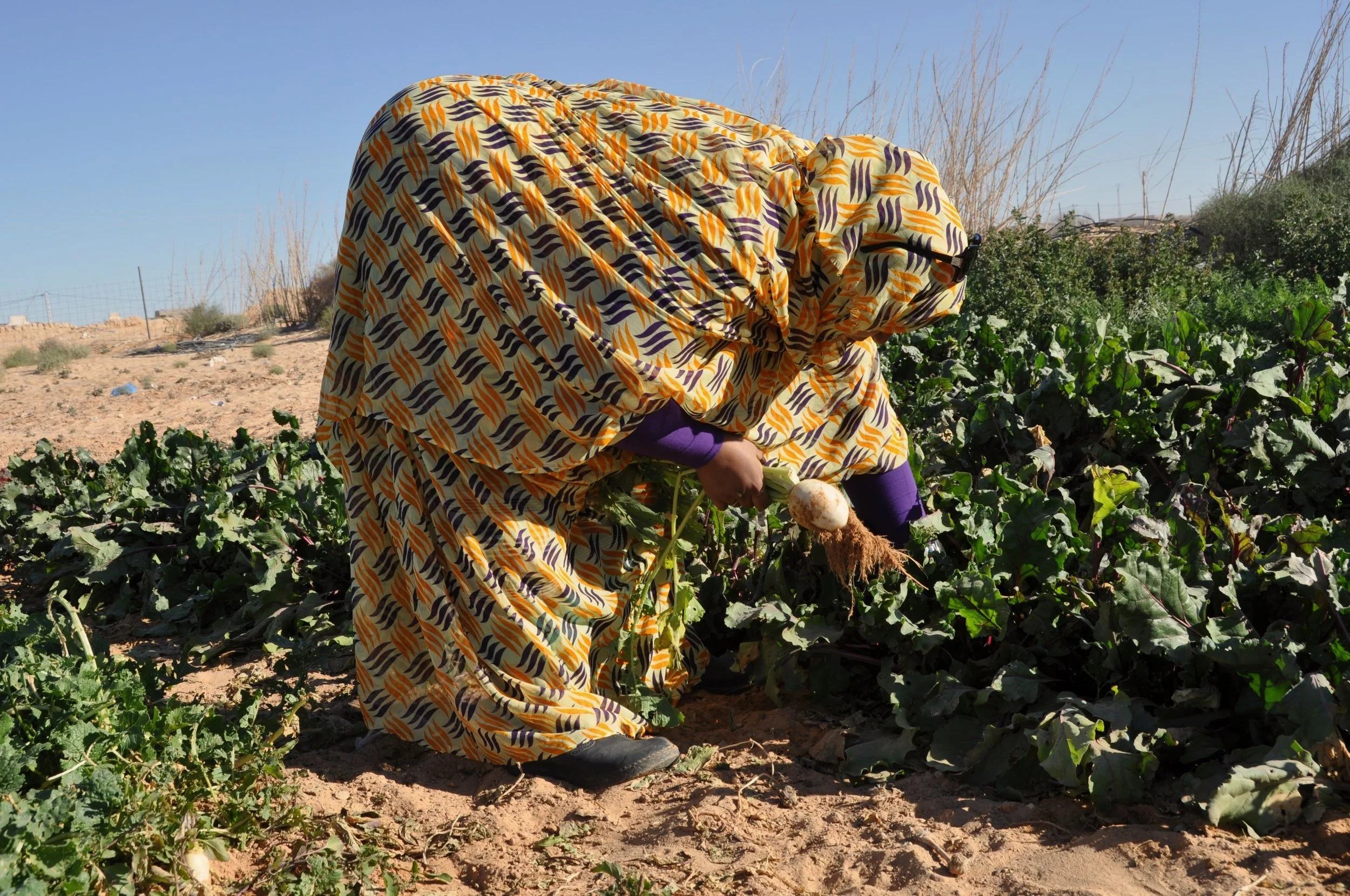The Sahrawis have been in exile since the occupation of their lands by Morocco. They ended up far from the sea they used to fish in, and found themselves scattered across refugee camps in the middle of the Sahara Desert, where the heat leaves the cattle thirsty and the cold kills the crops. To this day, the Sahrawis are almost entirely depending on humanitarian aid and food distribution to receive a bit of fresh produces.
I visited a project run by Oxfam in one of the refugee camps where women are taught agricultural basics and work at a community garden to reinforce their independence and food security. The final document was use as both a report to the investors in the project and a case study for Oxfam. All the pictures, interviews and texts were done by me.
“ It’s still early in the morning when Nesra crosses the metal gates that marks the entry of the regional community garden of Smara. She strides towards the back of the garden with Hama, her youngest son, by her side. With every step, the decor changes and the monotony of the desert is brightening up with different shades of green. From outside, it’s almost impossible to imagine that such a vibrant parade can occur. Yet, once you get in, it’s really easy to forget that this haven is located in the harsh Sahara Desert, surrounded by a refugee camp”.
“ For the past weeks, Nesra has come to the garden every day. With other women, she makes sure that the patch is visited twice a day to be watered and inspected for weeds. If you would’ve asked Nesra about agriculture only a couple months ago, she wouldn’t have been able to tell you much. Before participating to this project, the mother of three never took care of crops or done any farm work. At 32 years old, Nesra says she always loved to try different things and never missed a chance to learn new skills”.
“I found a good balance between my work, the daily housework and agriculture because it’s really important for me to commit to my crops”.
- Nesra
“The initial aim of the project was to recruit 50 families or groups to work on parcels of the garden to grow vegetables. The interest within the camp was high and 110 groups ended up being part of the initiative and Nesra’s team of women was one of them”.
“At first, everybody attended trainings about the healthy exploitation of the land, agroecology and farming techniques. With the support of Oxfam’s team and the engineer affected to their parcels, the participants were guided through every step; from preparing the seeds to getting the soil ready and finally sowing”.
“Born and raised in a refugee camp, Nesra spent her whole life coping with the rough conditions of a life in exile. She realized from early on that basic things like access to food and water turns into a real challenge in the desert. 44 years has passed since Nesra’s family fled what was known as Western Sahara to find safety in the refugee camps of Tindouf. Even though some things have changed through the years, other aspects of the life in the camps remained frustratingly static. The refugee population remains almost entirely dependent on humanitarian aid for the most basic needs. Food insecurity is a very important issue that has heavy consequences on the health of Sahrawis”.
“There is an important lack of opportunity to find nutritive food and fresh products in this remote and isolated environment, and most families are relying on the monthly food distribution as their main source. Unfortunately, a decrease in the funding allocated to humanitarian assistance has affected the quality of the distributions, yet the needs are as critical as ever”.
According to the UNHCR, only 20% of children under 2 years of age have access to a minimum acceptable diet, and more than 1/5th is stunt.
Amongst the population, anaemia, diabetes and hypertension are especially common.
“On top of health and economic benefits, this project gives a true sense of ownership to the participants who lived their whole life depending on foreign support to survive”.
“ Nesra brings vegetables home whenever she needs it, but she also makes sure to share her crops with neighbours and friends. It’s also significant for Nesra as a woman to be the provider for her family. She’s not only supporting her 3 children and husband, but also her parents, her siblings and their kids.
As well as the parcels dedicated to the participant’s crops, another section of the garden is used to grow vegetables that will be delivered to the population during monthly food distributions. Between 30 to 35 tones of vegetables is produced by each of the 12 employees working in that section”.
“When I am in the garden, I’m not a refugee. I am a farmer. We are all very happy of this new independence and I am proud to be the reason of it. My family is grateful that I decided to try this new project”.
- Nesra
“ In only a few days, as the warmth of summer is slowly setting back in, Nesra and the others will do the final harvest of the fields. Although this marks the end of the first year of activities for the regional garden, this is only the beginning for the new farmer”.
The pictures and texts above are excerpted from “Build the social and economic resilience of women and youth through the enhancement of food security”, a photo story on a Sahrawi refugee named Nesra.
Her testimony on her participation in Oxfam's garden project, funded by the Agence Suédoise de Coopération Internationale pour le Développement (SIDA), is both an encouraging report on the NGO's activities and a heartfelt insight into the reality of her people's exile.
The interviews, pictures, text and editing were done by me, with the precious help of Oxfam's Tindouf (Algeria) staff.














